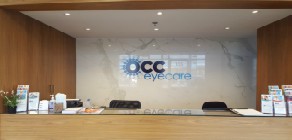MYOPIC DEGENERATION
Myopic eyes, either genetically inherited or developed overtime, have a stretched structure compared to normal eyes. As a result of this, myopia puts strain on the tissues of the eye, including the retinal pigment endothelium (RPE), macula, and retina. Myopic degeneration arises because structural strain from the stretching of the retinal tissue increases the risk of holes and/or tears and the development of other diseases.
WHAT IS THE CONDITION?
Myopic degeneration refers to the progressive weakening of the retina and RPE because they are being stretched within a myopic eye. It begins by causing tears in the peripheral retina which can spread into the macula. As the strain on the retina increases, the tears can develop into macular holes, which may eventually lead to macular, or even retinal, detachment. In addition, myopic degeneration leads to tears in the retinal pigment epithelium, a frontal tissue that connects to the retina.
When the RPE is torn, it stimulates the growth of abnormal blood vessels called choroidal neovascular membranes that also spread to the retina. Once on the retina, the blood vessels may bleed into the vitreous body, diminishing sight and/or forming scar tissue, also known as an epiretinal membrane, over the retina, blocking light from reaching it. Additionally, the stretching and tearing of the retinal and RPE membranes can lead to atrophy, the dying and wasting away of cells. Since both the retina and RPE are vital for vision, the atrophy of their cells further deteriorates the vision of a patient with myopic degeneration.
MYOPIC DEGENERATION
Axial myopia, in which the entire eyeball is stretched relative to a normal eyeball, causes tension in many of the tissues on the inside lining eye. Over time, these tissues may undergo degenerative changes that are not normally seen in the regular population. Myopic macular degeneration refers to the early degeneration of the central portion of vision due to layers of the retina being under traction. The retinal pigment epithelium (RPE) undergoes atrophic and tractional changes that ultimately lead to its compromise. Patients who have myopic degeneration can be difficult to distinguish from patients who have macular degeneration. Patients who have myopic degeneration may also have macular degeneration.
MACULAR HOLES
Patients who have high myopia can develop cystoid macular degeneration or foveal schisis formation due to their extreme myopia. Early diagnosis is essential in preventing the early schisis from leading to the formation of a full thickness macular hole. It is equally essential that regular investigations are maintained.
RETINA TEARS
Due to the enlarged eyeball that is frequently seen in patients who have high myopia, tractional changes extending throughout the retina may develop. These tractional changes can be associated with peripheral retinal tears, much like in patients who have lattice degeneration. These retinal tears tend to be located in the far peripheral of the retina and can be associated with retinal detachments. It is important that patients who have high myopia be examined and screened on a regular basis to prevent these complications from happening. Early treatment options include surgical intervention, laser intervention, and cryo treatment.
MYOPIC CHOROIDAL NEOVASCULAR MEMBRANES
The presence of myopic choroidal neovascular membranes is generally seen in patients who are highly near sighted. Due to the extensive tension upon the retina caused by the enlarged length of the eye, patients may develop breaks in the retinal pigment epithelium. These breaks increase the risk of faulty blood vessels growing through the breaks and into the retina. Fortunately, not all patients who have myopic bleeding will develop a choroidal neovascular membrane, since they may have a small blood vessel rupture without the associated new blood vessel growth.
Treatment options include intraocular injections to regress blood vessel formation and pneumatic retinopexy to displace the intra-retinal blood.
MACULAR DETACHMENT
Highly myopic eyes, especially those associated with colombomas with macular hole formations, can develop macular detachments. Macular detachment generally involves the entire posterior pole of the retina and can lead to substantial loss of sight. Very infrequently, patients develop a total retinal detachment with substantial loss of sight. Treatment options for this are surgical in nature.
RETINAL DETACHMENT
Patients who develop a retinal detachment with high myopia may become completely blind. In fact, retinal detachment in any patient may lead to complete blindness, irrespective of whether they are highly myopic or not.
PREVENTION
Regular dilated fundus examinations and scleral depressions by a retinal specialist may help identify the at-risk, or inherently weaker, areas of the retina. When caught early, or when the damage is restricted in size or location, there are preventative treatments that can be done to prevent many of the complications associated with myopic degeneration. The most common is laser treatment for peripheral retinal holes.
PROGNOSIS
Regular dilated fundus examinations and scleral depressions by a retinal specialist may help identify the at-risk, or inherently weaker, areas of the retina. When caught early, or when the damage is restricted in size or location, there are preventative treatments that can be done to prevent many of the complications associated with myopic degeneration. The most common is laser treatment for peripheral retinal holes.
MYOPIA
Patients who have myopia, particularly those with high myopia, tend to develop progressive changes in the retina. Very high myopes tend to have a longer axial length, on average 50% or longer than the average eyeball. Increased length correlates with increased stretching of the eye resulting in excessive strain, or traction, on the structure. This strain will cause peripheral changes and/or central visual changes. Central damage has more a profound effect on vision for daily life, whereas peripheral changes do not. With that said, some peripheral changes may progress and become central if left untreated. It is imperative that patients with longer eyeballs have routine and serial examinations to detect subtle disease.
Given advances in technology, eye specialists are even more equipped to treat at earlier signs. Unfortunately, many symptoms of progression are not visible to a patient until it is quite far along.
MYOPIC DEGENERATION
Myopic degeneration is the progressive traction upon the central or macular region of the retina. The rate of progression correlates with both the length of the eyeball and age. Myopic degeneration and macular degeneration are very similar, however, certain diagnostic tools, including Fluorescein Angiogram, OCT, and Microperimetry, allow retina specialists to differentiate between the two. Both conditions can appear in dry or wet forms, and may receive similar treatment.
MACULAR HOLES
Macular holes associated with high myopia develop tend to be progressive in nature since these patients often develop a foveal schisis, or cyst like formations, in the retina. These cysts can progress into partial thickness holes, and then into full thickness holes. More progressive holes become localized macular detachments. Once myopic macular holes form, sight will deteriorate, but will eventually stabilize. While central vision may be severaly diminished, the risk of complete blindness is minimal unless a total retinal detachment occurs through the central macular hole.
MYOPIC CHOROIDAL NEOVASCULAR MEMBRANES
In the past, patients with high myopia who develop a choroidal neovascular membrane in the central macular area were not treated due to the complications associated with the treatment. However, more recently, due to the development of new intraocular injection medications and other new treatments, therapies can now be offered to patients with high myopic choroidal neovascular membranes. Accordingly, the prognosis for a patient who develops a choroidal neovascular membrane is now more reasonable than it was even a decade ago.
MACULAR DETACHMENT
Patients who have very high myopia may develop macular detachments. This is generally seen in patients who have macular hole formations associated with coloboma. Macular detachment generally involves the entire posterior pole of the retina and can lead to substantial loss of sight. Very infrequently, patients may develop a total retinal detachment with substantial loss of sight. Treatments options for this are surgical in nature.
RETINAL DETACHMENT
Retinal detachments are associated with complete blindness when the detachment comprises of a large geographic area of the retina. While patients with high degrees of myopia experience a significantly increased risk of detachment, they can also occur in eyes without any at-risk findings.
TREATMENTS
Several treatments are offered to treat the conditions caused by myopic degeneration.
INTRAOCULAR INJECTION
KENALOG
Kenalog is a steroid medication that can be injected into the eye and is used to inhibit the growth of abnormal choroidal neovascular membranes, or capillaries, on the retina. It is widely used as an accompaniment to other treatments for patients with myopic degeneration.
AVASTIN, LUCENTIS & EYLEA
Avastin, Lucentis, and Eylea are drugs that blocks the growth of abnormal blood vessels. These drugs are known as anti-VEGFs, or anti vascular endothelial growth factor drugs. Abnormal blood vessels appear in many other neovascular diseases including diabetic retinopathy, macular degeneration, retinal vein occlusions, and many others.
LASER
Thermal laser treatment can be used to seal tears in the peripheral retina or to reattach the retina in places where it has detached due to vitreo-macular traction or myopic degeneration. Patients whose RPE cells are undergoing atrophy and are highly myopic may have trouble absorbing the laser. Moreover, since laser treatment carries the risk of worsening the symptoms of myopic degeneration, it is rarely used.
CYRO THERAPY
Cryo-, or freezing, therapy of the retina, like laser treatment, is used to either seal retinal tears or wield the retina back onto the eye after retinal detachment. In general, cryo therapy is only reserved for those patients for whom it is impossible to do laser treatment, or for whom laser treatments would be insufficient to hold the extensive areas of peripheral retinal tractional changes and retinal tears. Cryo therapy is better able to secure the retina in patients who have localized retinal detachment.
SURGERY
SCLERAL BUCKLING
Scleral buckling is a surgical technique used to repair retinal detachments. It involves the use of a band that wraps around the eye and closes the gap between the eye and the retina. More specifically, the procedure creates an indentation in the sclera and pushes the outer portion of the eye inwards towards the detached retina.
VITRECTOMY
A vitrectomy surgery, or the removal of the vitreous gel from the inside lining of the eye, is a complex surgery performed specifically for patients who have a variety of retinal diseases associated with their high myopia. A vitrectomy can be used to treat patients who have retinal or macular tears, macular holes, or retinal detachments.
Patients with high myopia who undergo vitrectomy surgeries do so for:
1. An associated retinal detachment
2. Foveal schisis
3. A macular hole formation associated with myopia
In many situations at the end of the vitrectomy surgery, the eye is filled with a balanced salt solution (a saline solution used exclusively for eye surgery), specialized gas bubbles, or silicone oil. The use of silicone oil for patients who have high myopia may reduce the risk of retinal detachments following vitrectomy surgery and is almost always mandatory in patients who have a localized posterior detachment of the macula associated with a myopic macular hole formation. Silicone, an inert substance, can remain in the eye for over ten years in some cases.

